A month before pitchers and catchers reported, the true stars of Washington Nationals games showed up at the stadium.
Most of them, 38 total, arrived before 8 a.m. on a 20-degree Saturday in January. People in the group ranged from early 20s to mid 60s, and we all stood in the cold, ready to see if they had what it took.
Doors closed at 8:25, no exceptions. Don’t talk in costume. Don’t give your last name in media interviews. No photography while the costumes were partially on.
This wasn’t so much an exercise in building character as it was an exercise in a character.
At every Nationals home game, the commanders in chief dash around the outfield during the fourth inning. Even in down years for the team, the Mount Rushmore-quartet of George Washington, Theodore Roosevelt, Thomas Jefferson, and Abraham Lincoln bring a high point to the games. After 2012’s success, William Howard Taft took his place on the starting line.
To make it this far, candidates had to clear the two-part process of an application followed by five open-ended questions. Then, after an on-the-field tryout, each person sat for a panel interview.
First, you had to prove you could move.
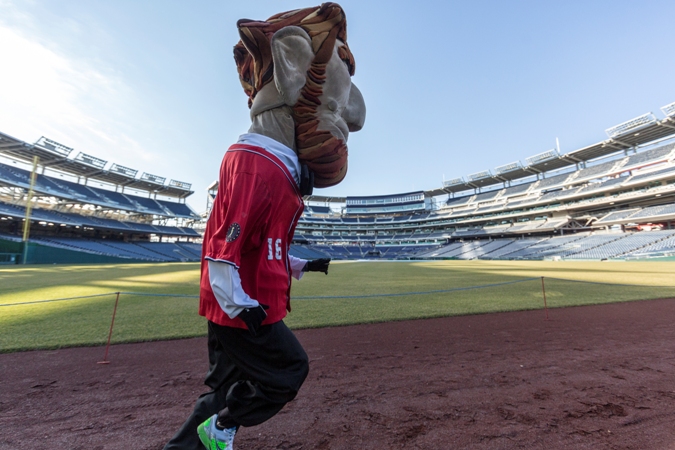
Everyone at the tryouts had to run a 40-yard dash and two full circuits of the race course, from center field to first base and back.
Abe, George and Teddy were on deck for the day. Being from Illinois and having grown into a lanky frame, I wanted to embody the best the Midwest has given this country — our 16th president.
Just like you and I, the presidents put on their pants one leg at a time. Abe’s black slacks are held up with something close to mesh suspenders, but the pants don’t make the politician. The bulk of each of the costumes rests in the 45-pound head. Small metal pipes form an exoskeleton to which the head attaches, and weight is distributed down through the contraption.
An assistant held the head while I slipped my arms through shoulder straps and locked three buckles across my chest, similar to what we all did with our middle school backpacks, except these straps provided necessary support.
The all-important Nats jersey tied the costume together and hid the guts and the secrets of the Presidents that participants in the open tryouts got to see. But the insider’s view has to stay that way once a normal human transforms into a living caricature of our nation’s former leaders.
“Do you know who Mickey Mouse is?” asked Tom Davis, senior manager for entertainment. “It’s important to keep that magic of the whole persona. It’s important to be able to become that character.”
“If I hired John Doe to be a President, I don’t expect to see John Doe playing the part of Abe. I expect to see Abe. It really is every facet. All the Presidents have their own personalities. Abe is that guy out there that he is a relentless winner. He likes to win races. When you see Abe out there racing, you want to see the Abe that everybody else saw the 10 games before.”
Yet any character traits flow from a basic ability to handle the heavy costume. I trained six days a week with runs, swims, spin classes and weight lifting, so even with no mascot experience, I was confident I could handle a few strides in the ballpark.
“The biggest thing is getting over the mindset that you need to be a long-distance runner or a college track champion,” Davis said. “That’s not really what you need to do to be a great President.”
After the initial 200-yard scamper around the warning track, I stood near first base sucking wind as if I’d just run stadium steps all morning. I would have needed to regularly tote a five-gallon CamelBak above my head on my runs through the city to have any advantage. Plus, those straps that kept me in character also transformed routine oxygen intake into an ordeal that required concerted energy.
Still, the more important task was to focus on where I was headed — really, where my head was headed. Every movement in character demanded a full-body commitment, especially a turn.
“As soon as you take that turn, your head wants to go one way, but your feet are trying to go another way, and there’s the wall getting closer,” said Artie, one of the participants trying out for the first time. He played baseball in high school and briefly in college, and similar to many of the participants, he’d quickly internalized the idea of adopting a personality that could serve the larger team.
“I was here for all the post-season games in 2012. The electricity was amazing. I couldn’t imagine being on the field with everyone cheering for you, or the President you are. I know there’s people in there. I wasn’t ignorant to that in the past, but they’re still Presidents to me. I’m still calling them by Teddy, Abe, Taft, Tom.”
***
Despite any mental cohesion with a character, the physical reality of limited vision hampered everyone. You can see more from inside a football helmet than you can from one of the presidents’ heads. I peered out from a tiny mesh porthole near Abe’s bow tie. My forehead wound up with a few minor abrasions because I needed to brace against the costume’s swaying.
Falling didn’t appeal to me, so before the tryouts, I had thought about how the body of a president costume would affect my motion.
My legs were fine; what changed was my center of gravity, that point that we all had to recalibrate in our awkward teenage years. Even the cool kids had to do this; they just managed it faster.
You want to be a cool kid inside Nationals Stadium.
A person’s center of gravity means a lot, physically. It dictates how we walk and how we run. Identical to their real-world counterparts, Racing Presidents depend on an even keel, not haste. Balance and stabilization precede speed, so once you find your center and learn how to move with it, you’re winning races.
“A small step can sway you,” said Marissa, one of four women who tried out. “A tiny bit to the right really is a big step to the right. The littlest thing makes a big difference. You have to be more in tune with the weight that you’re carrying.”
In other words, Racing Presidents win from the core, not from the legs.
Previous experience is not a deciding factor in the tryouts and the Nationals hire a variable number of qualified applicants each year. Marissa had a few prior mascot experiences, including her time as Bruce the Aluminum Can, a character who promoted a recycling program in grade schools near her college. Marissa’s work friends told her about the presidents opportunity.
“They know about my unbridled enthusiasm for mascots,” she said. “If all else fails, I made it to Nats Stadium. I put on the costume. I ran for president. That’s a resume thing. Ran for president: one day.”
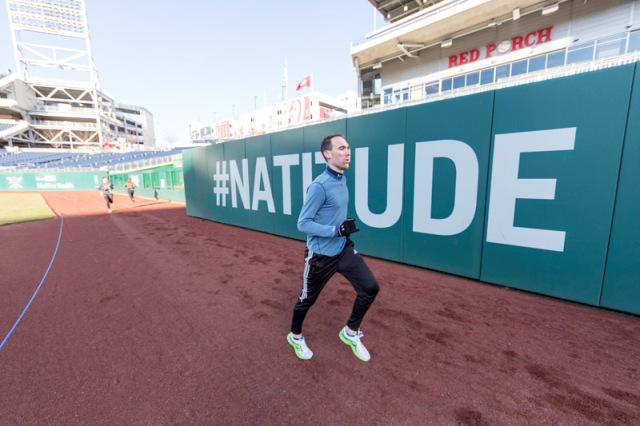
I cruised through the 40-yard dash in 8.59 seconds. Short strides and quick arm swings meant victory. Like my chosen leader, I won my presidential races too, and in doing so, carried on a tradition.
Abe, missing his signature stovepipe hat, leads the all-time season standings with 239 wins, beating George at 178.
Artie, Marissa and I all stayed upright for the duration of our campaigns, but not everyone did. The stumbles and tumbles provided the best entertainment on the field. If life is about falls and how you rise after them, you don’t want to spend time wobbling around as a professional mascot.
A character’s body would cave from the waist up as the forehead of one of the venerated forefathers cruised from the air into the warning track dirt. The collapse typically involved windmill arms, but once the head sank past the tipping point, the only variable left was how funny the scene would look as the President hit the surface.
Sometimes, it was a slide. Other times, the former leader of the free world bounced to a stop.
Just watching someone try to lift from the ground felt arduous. Imagine a few sacks of potatoes suspended three feet above your head, and picture your attempt to stand on two feet after looking at a vertical horizon.
Regardless of slips or speed, though, the transition in and out of characters took place behind the center-field wall.
Following a time in costume, it’s easy to more fully appreciate the axiom about a weight off the shoulders. Several people, including me, completed a hop-skip with a few arm rotations. That signaled an adjustment back to a familiar sense of self, much closer to the ground, because, for a little while, we were larger than life.
When I decided to write about what it was like to be a Running President, the Nationals made me choose whether I be at the tryouts as a reporter or an applicant–or candidate. But I couldn’t help but wonder what I would do if offered the job.
After all, being the president is a lot of responsibility, no matter which era you’re in.
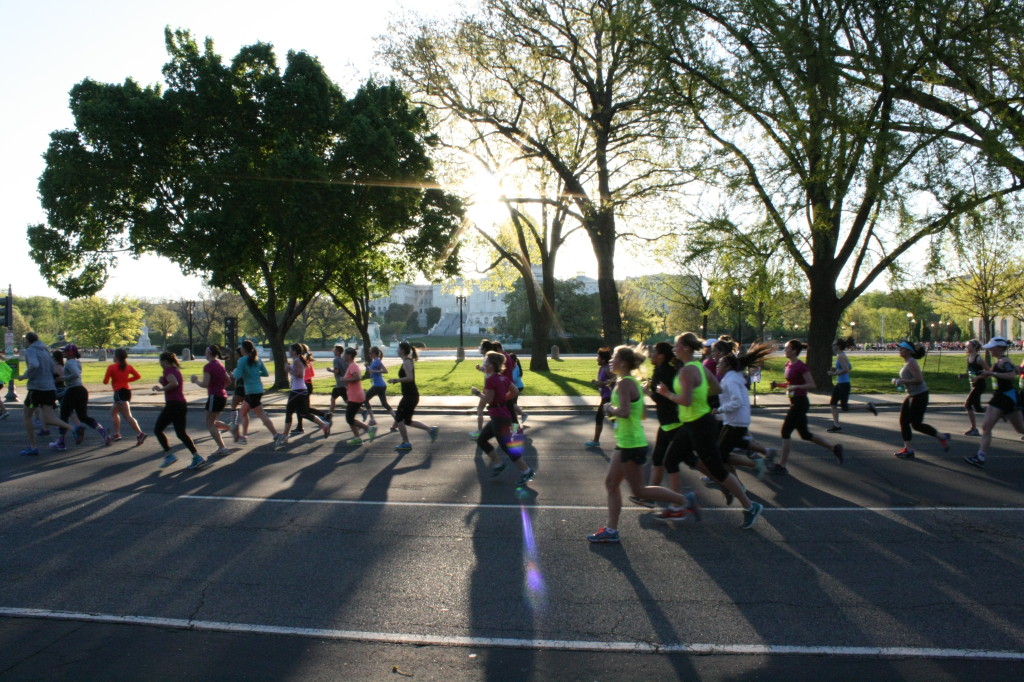
Kaitie Sheedy has run along Rock Creek Parkway alone before. She’s done solo loops of Hains Point. Now she’s done it leading a half marathon.
The D.C. resident won her first major event at the Nike Women’s Half Marathon in 1:20:53.
[button-red url=”http://werundclive.com/dc14/#/tmr/leaderboard/overall/1″ target=”_self” position=”left”] Results [/button-red]“It was really nice to race in a place where I’ve trained the last several years,” she said. “It’s always nice when you can jog to the starting line from your house.”
Sheedy said the win served as a perfect tune-up for next month’s race in another capital: Canada’s Scotiabank Ottawa Marathon. She took the lead on Hains Point and found herself alone in front.
“I’ve never really been on my own before in a race. It was a good experience to get used to that, listen to my body, and just go with how I was feeling. I’ve been training really hard, so I was like, don’t freak out. Be relaxed. Trust your training, which is always kind of scary.”
Third-place finisher Ann Mazur (1:22:58), of Charlottesville, brought a different training background to the race. Although she ran low mileage in college track and cross country at Notre Dame, she’s dipped even further in recent months while working on a doctorate in English at the University of Virginia. Mazur teaches yoga and swims, but she said she hasn’t run much more than an hour since December, and her weekly mileage has stayed around 30.
“I had no idea how today was going to go,” she said. “Stay in the top three. Don’t die. That was the goal once I hit mile eight or so.”
Mazur says despite the reduced mileage, running has helped her through the days of earning a doctorate.
“You do a lot of sitting down, and frankly I have a really hard time sitting down and getting my work done if I haven’t moved around a whole bunch first.”
To add to her Sunday podium finish, she successfully defended her dissertation on Friday.
“It’s been a really insane past three days.”
New York City resident Leigh Gerson (1:21:59) took second.
For the most part, the race catered to women new to the sport or new to the distance. The 13.1 miles were a first for almost one-third of the runners.
Wearing a tiara and cape, D.C. resident Paige Fetzer completed her first half marathon on the cool, sunny morning. The racing world isn’t foreign to Fetzer, but the former triathlete’s work overseas hindered her swimming, biking and running routine.
“It was hard to maintain training since I was in places like Colombia and Iraq,” she said. “Since I moved here, I started getting back into training. I love the atmosphere of races. Everybody’s encouraging you. There’s so much solidarity and motivation. It gives you the runner’s high you can’t just get on your own.”
Race officials estimated that approximately 15,000 participants raced, and that huge group included Maj. Nancy Harris, based in Fort Dix, New Jersey, with the 174th Infantry Brigade.
Harris had never entered a race before.
“I was like, this is a lot of people, oh my gosh,” she said. “I was so nervous. I started out too fast. I don’t care. I’ll do it again. I’m in the Army, so I run because they make me run, not because I like to. Now, I like to run. I’ve already signed up for two more races.”
Harris joined Team in Training, the race partner whose team members raise money for the Leukemia & Lymphoma Society and its blood cancer research.
Among the purple-clad Team In Training runners was Reston’s Liz Badley. Her team, Out For Blood, collected more than $13,000 for the charity.
Her first race in a tutu scored her a 10k PR and an overall PR.
“My goal was a tutu PR,” she said with a laugh. “I was in a boot last week because I hurt my ankle. I told my doctor I was going to run, doesn’t matter.”
Badley said she wanted to run negative splits starting at 9-minute miles, but she cruised through mile one in 7:32.
“I was like, OK, guess my plan’s out the window.”
The motivations for entering the half marathon varied from picking a race with coworkers, like Sarah Casarella, New York, to finally running an event in Washington after having lived here for a few years, like Kelly Langhans, Arlington.
For some, the race was about family. Jessica Kloppenburg, a junior at Georgetown University, said she and her sister Alex, New York, signed up for the inaugural Nike race in DC last year, but neither were able to run it. They brought their mom Lauriann, who lives in Boston, along this year. She and her husband started running to stay in shape and allow themselves an excuse to eat good food.
“It’s turned out to be a family activity,” she said.
Food also motivated Lynne Still, of Radford, Va., who said she planned to eat a pile of pancakes after avoiding them for several months. Yet Still expressed the most common reason for selecting the Nike race over other races in late April.
“I wanted to get this necklace,” she said.
Men in suits presented finishers with a coveted Tiffany & Co. necklace in the recognizable blue box.
The Run Nike Women race series has also hosted events in San Francisco for a decade, where Kathleen Malone, of Connecticut, has run the full and half.
Malone has completed a dozen marathons, but the training has taken it’s toll. She wants to focus on the half distance, and she ran the 2013 Nike DC race.
“At the end of the day,” she said, “it’s the little blue box. I have a lot of medals from marathons, but the necklaces are a whole lot more practical.”
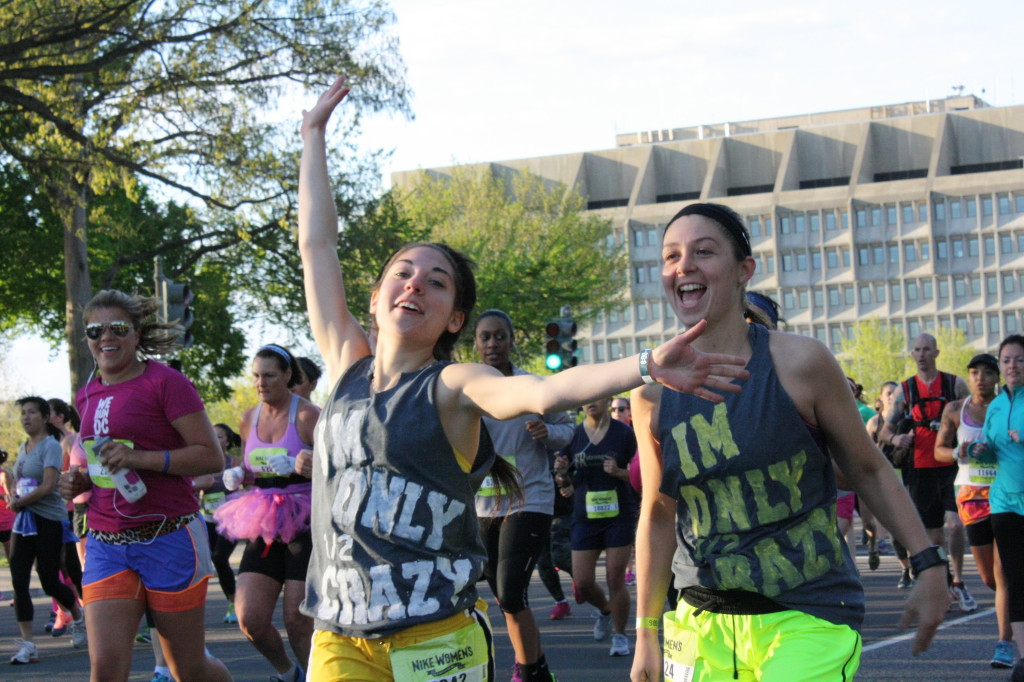
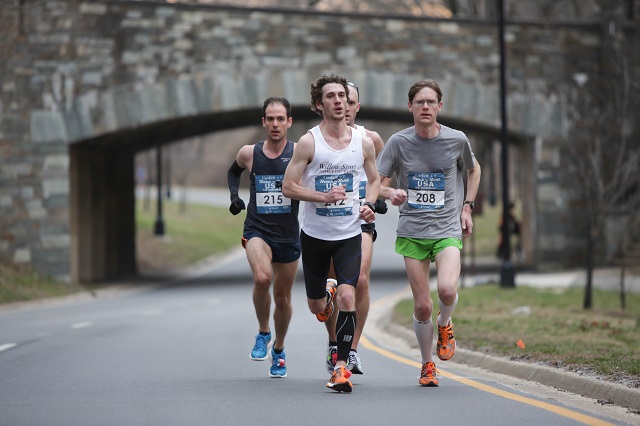
The leaders at the Rock ’n’ Roll USA Marathon left no doubts. Across the board, between the half marathon and the full 26.2 miles, both the men’s and women’s races held little suspense. Local runners represented the area well in the top groups of finishers, and after an endless winter, runners rejoiced for sunshine and warm temperatures on race day.
HALF MARATHON
[button-red url=”http://running.competitor.com/cgiresults?eId=54&eiId=174″ target=”_self” position=”left”] Results [/button-red] Abiyot Endale allowed a costumed Superman to lead the pack down Constitution Avenue, but Endale and a group of three other runners raced away from the field. Even then, the race effectively ended under the Kennedy Center overhang as Endale stretched his lead with a relentless, effortless-looking stride.
By the time he crested Calvert Street hill, the other runners couldn’t be seen and Endale ran alone. A smile and a wave to the drum corps outside Howard University served as a rare indicator he was even aware of the surroundings on his way to a 1:06:27 win in the men’s half-marathon.
Endale has proven himself as a capable winner before. He won the 2012 ING Hartford Marathon in Connecticut and set a course record that day.
Ayele Kassaye (1:08:29) finished in second on Saturday. Matt Rand (1:09:24) took third in his debut half marathon and finished as the first local man in the race.
On the women’s side, Christine Ramsey made the trip down from Baltimore to secure the only close race of the day, a 1:19:27 win in the women’s half marathon, ahead of locals Kerry Allen (1:19:46) and Teal Burrell (1:21:37). Ramsey improved on her third-place finish in this race last year.
Locals from Virginia and D.C. made up more than half of the approximately 25,000 registered runners, but the race still included participants from all 50 states and 33 foreign countries.
Dick Whitfield, Newark, Ill., drove to the nation’s capital for the weekend to visit family. He sat with Laura Whitfield, who lives in Baltimore, for an picnic with post-race snacks in the RFK parking lot.
“She sent me an email and said there was a fun run out here,” he said as he pointed to Laura. “Our winter’s been so terrible. I haven’t run all winter. I’m going to start training Monday,” he said with a laugh.
Laura said she hasn’t run much either. “We knew we’d finish. We weren’t out there for time.”
Weather typically sits at the top of the list for boring conversational riffs, but runners from across the country admitted that their training had suffered in some way from the barrage of snow and sub-zero temperatures this winter.
“We’ve run through snow, ice,” said Aubrey Brown, of Richmond. He faced the challenge of training with a friend in another city, Melanie Sala, who lives in D.C.
“We ran through the polar vortex,” Sala said.
The two embraced after the finish line. They ran all 13.1 miles together. The pair started training in November, and Brown completed his first race at this distance.
“We’ve known each other for a while,” Brown said, “and it was the next thing in line.”
“We decided this was an experience we wanted to share together,” Sala said. “Step by step.”
“I had to slow her down just a little bit,” Brown said. “Every time a band came or a small child appeared, she felt like she needed to speed it up a little bit,” he said, laughing. “I had four goals: the first goal was to start.”
“That is the most important thing,” Sala said. “Begin and then continue. That’s all you have to do.”
Brown’s other goals included avoiding injuries during the race, finishing and having fun with his friend.
“All the boxes checked,” he said.
Friends and families served as great motivators for many runners at this distance.
Erin Leo, D.C., tore her ACL playing basketball in college, and that’s when she started running half marathons. Her younger sister Kate Waldon, Boston, cheered for her sister during that first race.
“I thought she was crazy when she ran her first one,” Waldon said.
“And now she’s done like 15,” Leo said, “and is trying to get me to do a full.”
The sisters have run nine half marathons together, beginning with the D.C. half marathon race four years ago.
For Courtney Cecere, McLean, the Rock ’n’ Roll half marathon served as her first race after a new addition to her family, a now 13-month-old daughter. She trained for the event with a local group called Moms Run This Town.
“A baby changes the training time,” she said. “Not so much that it’s physically more challenging, but just the time juggling. Making sure my husband can be home if I run real early and adjusting when I run.”
Many finishers rushed for the coveted medal, a signifier of achievement, but Cecere had another idea.
“I’m excited to go see my daughter.”
FULL MARATHON
A former Olympian led the full marathon field from miles three to 11 on her way to the women’s title. Nuta Olaru ran 2:43:00, fresh from taking the crown at the 2014 USA Cross Country Championships, where she won the masters women’s 6k in February.
“I pushed when the men caught me,” she said. “I didn’t realize I was also first place. When the men caught me, I knew, oh my gosh, I was first overall.”
Olaru, competing for her native Romania, finished 13th in the women’s marathon at the 2004 Olympic Games in Athens, Greece. She now runs for the U.S. and trains in Longmont, Colo.
She said the Rock ’n’ Roll Marathon fit well with her training schedule because she’s headed to Boston in April. She finished more than 10 minutes ahead of second place, Rebecca Bader (2:53:10). Kristin Johnson (2:57:54) finished third and crossed the line as the first local woman.
“I didn’t actually realize she was running the marathon until I actually passed her and saw her bib,” said men’s marathon winner Adam Doherty.
Full marathon racers wore red bibs, and half marathoners wore bibs with a blue stripe.
“Success on every front,” said Doherty, who locked in his first place spot by about the halfway point and cruised to a 2:33:52 finish in his debut marathon.
“Definitely tough mentally,” he said of running by himself. “Just clicking off splits. That was really what I was looking for. I was hitting 5:50s pretty much the entire second half.”
Doherty, of Charlottesville, Va., said he wanted to run the marathon distance after his collegiate racing schedule ended with graduation last June.
“I’m really competitive, so I wanted to be in a race I could actually compete for,” he said. “I’ve knocked it off the bucket list I guess.”
Brian Benestad (2:36:32) took second. Eric Senseman (2:39:52) finished third and matched his place in last year’s race.
Several runners mentioned the timing of the Rock ’n’ Roll race because it happenes early enough to provide a firm benchmark between winter training and the Boston Marathon.
Dara Dalmata lives in Hopkington, Mass., the town where the famed marathon starts. She finished seventh in the women’s field on Saturday in her first race since Boston in 2011.
“I didn’t hit the wall at all,” she said. “I left the pace team at 23 miles. The pace team was great. You didn’t have to think. I would definitely recommend that to people if they want to break a time.”
The pacing groups received praise from many runners who credited the teams with providing a needed boost on the long course.
“That was fantastic,” said Veronica Mazariegos, D.C. “It’s lighthearted, keeping together, helping each other. And at the end, if you feel like you can, you push a little harder.”
Mile pacing and Boston’s big event were also on the mind of Mindy Ko, of Arlington. Her twin sister, Phebe will run Boston next year, so Mindy needed to qualify.
“This is the perfect course to do it because I don’t have to travel, don’t have to worry about those logistics. It’s kind of in my backyard as much as you can get.”
Although Ko has finished two Ironman triathlons, she’d never completed a marathon by itself.
“This is the first that I’ve done without walking and without biking and swimming first. In the middle of it, it was funny because you get these thoughts in your head. You see the Metro. You see the busses. And you’re like, oh my god, it’s so tempting. But you keep on running. You build this unspoken camaraderie in the second half.”
Marathoners split from the half marathoners near RFK Stadium, which brings them just within sight and sound of the finish line.
That tantalizing glimpse becomes a right turn toward another long stretch of road.
“It didn’t matter,” said Nico Gomis, D.C. He runs only two races every year, both marathons: Rock ’n’ Roll and Marine Corps. “After 20 miles, it’s all heart.”
FAST STATS
25,000 entrants
24,000 bottles of Gatorade
13,000 feet of fencing
6,625 latex gloves
3,600 Band-Aids
2,500 volunteers
2,500 road cones
375 Port-o-Johns
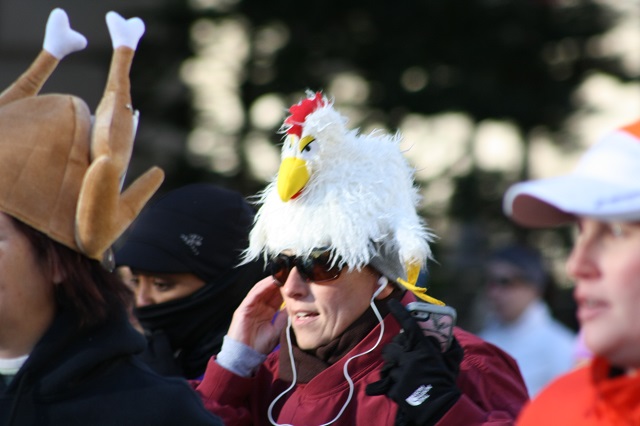
Thanksgiving, a day organized around gatherings, started with a cold race for thousands of people. More than 10,000 registered runners preceded any pie with the SOME (So Others Might Eat) Trot for Hunger.
For many participants, the 5k embodied the essence of the holiday.
“This one is a big one for the whole family,” said Lianna Nguyen, of Annandale. “We’re all here for Thanksgiving, being thankful we have our healthy family.” Fourteen family members joined what Nguyen called a “well-organized race.”
Many families wore matching shirts or sets of the same themed hat. Turkeys with legs that tied to keep them on in the wind, turkeys with drumsticks in the air that might have come straight from the oven, chef’s toques and slices of pumpkin pie all bobbed down Pennsylvania Avenue.
“It’s a family tradition to run on Thanksgiving,” said Christine Billings, of Castle Rock, Colo. Her family members from Colorado and Utah travel to a new state each year for the holiday, and they pick a race at their destination. After seeing photos of last year’s race, they ordered nine matching turkey hats for the event.
But the weather also called for gloves and scarves.
Wind chills at the race start were in the 20s. Normal highs for this time of year are still above 50 degrees, according to Capital Weather Gang at The Washington Post.
“I wore enough clothes,” said Scott Allen, “more than I normally wear in a race.” The DC resident won the Trot for Hunger in 16:04. “I’ve been in worse wind, but it was pretty rough. I was expecting to go faster.”
Allen caught early leader Dustin Whitlow (16:31), of Arlington around the two-mile mark. The Trot served as a tune-up for the Rehoboth Beach Seashore Marathon that Allen will run on Dec. 7. He said he typically doesn’t come out for Thanksgiving Day races, but an injury in the spring left him unsatisfied with his performances this year.
“I wasn’t able to train a lot this summer,” he said. “I didn’t get the full season I wanted.”
Rosemary Barber, of Springfield, Va., won the women’s race in 18 minutes flat.
The second-place finisher for the women was Vicky Schandevel (18:59). She was in town from Charlottesville, visiting her sister in Silver Spring. Schandevel said the wind was brutal on the finishing stretch, but the SOME event has become a tradition for her family.
“It’s one of the races I really look forward to,” she said. “Something about being here on Thanksgiving in downtown Washington, DC — it’s a great way to remind ourselves what we’re thankful for.”
Sarah Kessel, of Greenbelt said the event is the only big race her family joins. Kessel’s dozen relatives and close friends included Architha Vishnuvajjala, also of Greenbelt who had donated to SOME before but never run the race.
SOME raised nearly a half million dollars for its work in the capital.
“It’s more than we expected,” said Linda Parisi, SOME’s chief development officer. She said the goal was $450,000.
“We started on Ohio Drive with 100 people,” Parisi said. “We’ve grown every single year.”
SOME has organized the 5k for the past 12 years. The organization was founded in 1970 to help feed the poor, but its role in the community has expanded to include counseling, health care and housing. Yet food remains a major part of the mission, and SOME serves more than 1,000 meals every day.
The Carrollsburg Fundracers were the top team for donations, and they collected almost $14,000.
“SOME does really great work,” said Carrollsburg team member Jenny Harper. “Everyday services, but also working to provide transitional services like mental health care and job training. We think they have a good model.”
The Carrollsburg group represented the other side of the holiday. “Our Thanksgiving we do is a group of friends,” Harper said, “the kind of friends who are family.”
Plenty of people have the image of a long dining room table filled with family members reminiscent of the classic Norman Rockwell painting. But the Friendsgiving tradition has gained momentum in recent years, especially in cities like Washington, which boast clusters of geographic transplants.
Matthew Adamczyk, of Chicago said he discovered the SOME Trot several years ago when he spent a Thanksgiving alone in DC. This year was different. He ran the race with five other dancers of the Joffrey Ballet, who are spending the day’s big meal at the house of a company member who is from the area.
“We all race in our off time as cross training,” Adamczyk said. “We decided on our day off between seven shows we’d come down here and do a run.”
The group is performing The Nutcracker at the Kennedy Center this weekend, an apt signal for the transition from the yellows and browns of the late fall to the reds and greens of the winter racing season.
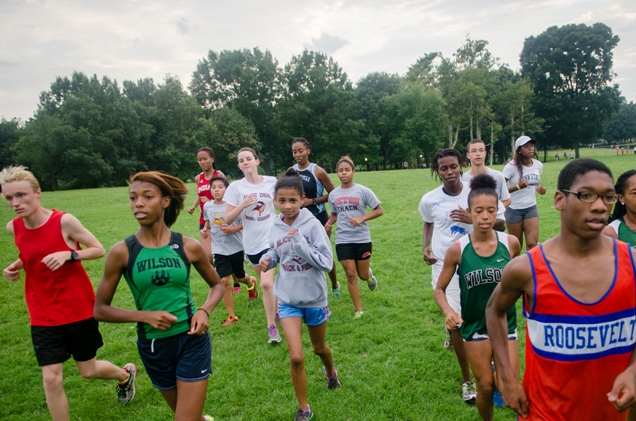
Photo: Jimmy Daly
By Dustin Renwick
Around the region, high school athletes log sweaty summer miles in preparation for the 2013 cross country season.
Pavement, trails and maybe a track or two keep these runners in shape for a fall that will hold several changes, all of which affect the postseason. Washington, D.C., has a date for a real state championship. State qualifiers in Maryland will test a new course. Realignment kicks in for Virginia high schools. For the most part, regular seasons remain intact, but that means these shifts are all the more important because runners will test them at a time when the biggest trophies and the brightest glories are in reach.
DC finds a date
College coaches looking for top recruits have an easy starting point in the state meet results. A champion doesn’t guarantee success, but a state meet title provides a glimpse of talent. Washington, D.C., hasn’t been able to provide a definitive champion in the past because the city doesn’t host an official state meet.
The mayor’s office created the District of Columbia State Athletic Association in 2012 with the idea that sports should have parity and athletes should play by the same standards in the postseason.
This year, the DCSAA will host a meet on November 2, a date between the championship races for the public and private schools in D.C.
“We want to have a state championship at the end of the year like every other state does,” said Kenny Owens, DCSAA statewide special events coordinator of athletics. “With this type of structure, we’re able to give kids more exposure rather than the regular league championships.”
The organization hosted its first state meet last year at Fort Dupont Park, but the date coincided with the Maryland and Washington, D.C., Private School Cross Country Championships. Teams were forced to choose between races, an untenable position for any event claiming to hold a definitive state title contest. Only a dozen schools attended.
Owens noted that one goal of the combined meet is to allow athletes to showcase their skills and give them a higher profile for college recruiters.
“You might be the best in your league, but there’s another league or school across the city that has great athletes, too. It brings up the level of competition.”
Right now, strictly comparing times between the events for the D.C. Interscholastic Athletic Association and the private school championships remains almost impossible.
That in itself stands as an illustration of the difficulty any athlete encounters when trying to claim the title of best runner in D.C.
“I think people have bought into what we’ve created and what we’re trying to do,” Owens said. “They see structure is being built where people are playing by the same rules.”
The DCSAA has named 46 schools in D.C. eligible to play under its guidelines. The organization encompasses public schools, public charter schools, private schools and parochial schools in the District.
Membership is voluntary, and there’s no guarantee of everyone showing up at the start line in November. Yet a fair opportunity presents itself this year.
“Our goal and our hope is that if you have a cross-country team, you want to participate,” Owens said.
Marvin Parker, head coach at Dunbar, said the race makes sense given that D.C. stretches a mere 68 square miles.
“It’s important to have our kids run together,” he said. “If you’re going to make an All-Met team, it’s easy to make when everybody’s had the opportunity to see each other.”
His team competed in the inaugural DCSAA championship last year, held at Fort Dupont Park on a different course than the DCIAA meet. A site has not yet been determined for this year’s race.
Hereford won’t host in Maryland
“When you think Maryland cross-country, you think Hereford High School,” said Seann Pelkey, head coach at Quince Orchard and this year’s meet director for the 4A West region.
The school has held every cross-country state championship since 1980 with the exception of two years. Exception number three comes in 2013. Hereford Athletic Director Mike Kalisz sent an email detailing the changes. Pelkey received the email on July 5 and sent it to local running websites to post.
Kalisz wrote that “extensive school renovations” at the high school will force the cancellation of the Bull Run Invitational in September. The course itself won’t experience any changes until November, according to the email, but Kalisz wrote that other elements of the construction process “will not allow us to guarantee a safe environment for all athletes and spectators.”
The Maryland Public Secondary Schools Athletic Association has not yet identified a new course for this year’s state championship.
“We’ve been spoiled at Hereford,” Pelkey said. “The staff at Hereford do everything to get that course ready. Anyplace else we go is going to involve a lot more work, I’d imagine.”
With the course out for at least this year, though, coaches who have lobbied to move the meet in the past have another opportunity. Complaints against the course have focused on the challenging layout that includes plenty of hills and the
fact that slower times at the event could negatively influence college recruiters or national meet selections.
“It’ll be interesting to see if those people have more of a voice,” Pelkey said. “Hereford is one of those courses that never lets you settle into a rhythm. Teams may be physically gifted and ready to roll come state time, but the course beats them mentally.”
Quince Orchard took second in the girls 4A race last year, and Pelkey said the new course won’t alter regular season training. But travel could become a factor in planning for the fall. He said the team might switch around its schedule to get a feel for a new course if there is a regular season race held at what would be the state site.
Virginia shuffles postseason structure
More than 300 high schools in Virginia all face the implementation of a statewide postseason overhaul. The changes come as part of the Virginia High School League’s realignment plan for the 2013-14 and 2014-15 school years.
The most distinct modification is that the state will switch from a three-group system to a six-class system.
Under the old arrangement, schools were separated into the three groups. Schools with the smallest enrollments comprised Group A. Each group had four regions composed of districts, each with up to 11 schools.
Now schools will be placed into classes, starting with the smallest enrollments in Class A. Classes A through 3A will split into east and west regions. Classes 4A through 6A will divide into north and south regions. All regions will contain four conferences, each with up to eight schools.
Such semantic changes do carry actual consequences.
For example, the Chantilly Chargers won the boys Group AAA state cross-country title in 2012. Chantilly ranks as the seventh-largest school in the state, according to March 2012 enrollment figures used by the VHSL’s executive committee. That puts the school in the new Class 6A, the designation for the largest high schools.
“I don’t consider these changes to be an advancement,” said Chantilly head coach Matt Gilchrist. “I’m not happy about it. I think the realignment is a football- and basketball-motivated switch. From a track and cross-country opinion, if it isn’t broke, don’t fix it.”
Several potential problems could arise with the new system when viewed from a cross country standpoint.
The state championship for cross-country will hold six races instead of three, meaning a two-day meet. Plus, six teams from each region now qualify for the state race instead of four. That math increases the total number of teams running on the state course to 72, from 48 in the old structure.
“What happens on Friday if it’s raining, and the course really gets destroyed?”
Individual standards also undergo a revision in the VHSL guidelines. In the old setup, the top 15 runners in each region qualified to race at state. The new policy will cut the number of spots to 10, but those 10 individuals cannot be members of the six teams that qualify.
“Now that kid in 17th, you wait until meets over, and did I get one of the 10 spots?” Gilchrist said. “Maybe that’s a blessing in disguise. I’ve had enough kids finish in my career in the 16th to 20th spots.”
However, Gilchrist said the new rules need to be tweaked. If five runners from the same school were to qualify as individuals this fall, they could not score as a team at the state meet.
“Don’t let them bring a full seven,” Gilchrist said, “but if you have five individuals, you should be able to score as a full team just like any other team.”
Gilchrist said he’ll prepare his team as usual in light of the modifications.
“You train the same way. You race the same way. You assess your team based on what you think they can do, and hopefully come postseason, that’s good enough to move on.”
The realities of these changes mean area coaches and school administrators have to think about new schedules, different travel plans, and the general sense that questions might outnumber answers until closer to the start of the school year.
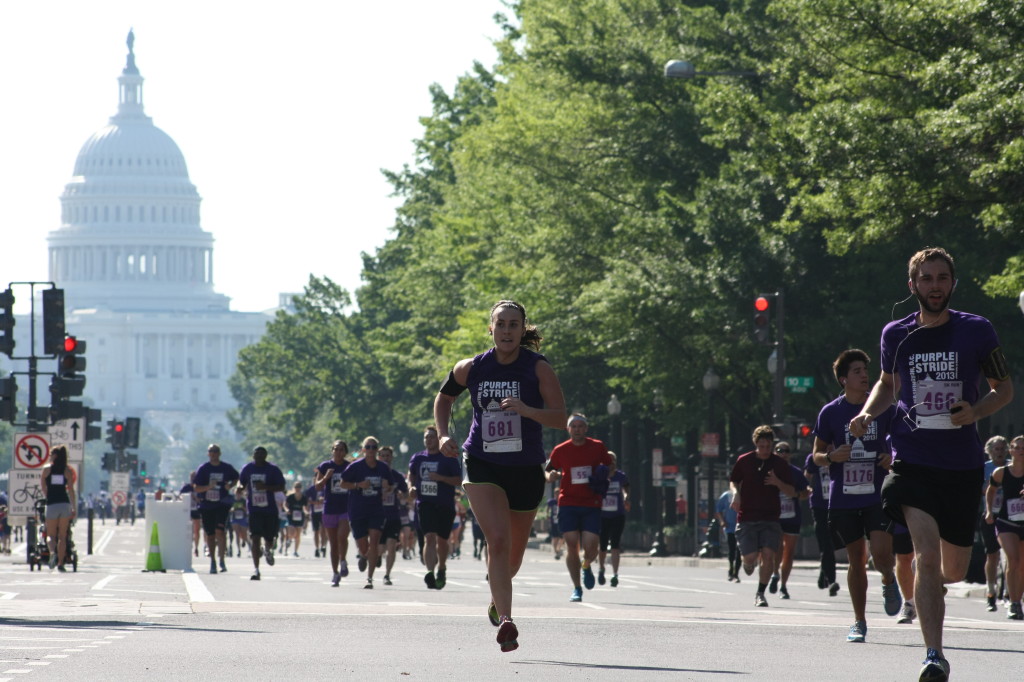
Sweat can cure many of life’s minor ailments, but not pancreatic cancer. More than 4,000 runners and walkers raced down sunlight-studded Pennsylvania Avenue on June 15 in support of research for pancreatic cancer in the PurpleStride 5k, held by the Pancreatic Cancer Action Network.The 5k provided a venue for local runners and for more than 90 cancer survivors, plus families and friends of people affected by the disease. T-shirts and signs in honor of loved ones filled the street, as did anything purple — tutus, dyed beards, glittering wigs.
[button-red url=”http://www.runwashington.com/PS_5K_Results.TXT” target=”_self” position=”left”] Results [/button-red]
Although the walk has been part of the D.C. scene for four years, the race was added just last year.
“It’s a way to bring people into our movement and learn about pancreatic cancer that aren’t necessarily impacted, people who are just runners and want to have a good run on Saturday morning,” said Julie Fleshman, president and CEO of the California-based Pancreatic Cancer Action Network.
Men’s overall winner Travis Boltjes, who lives in D.C., was part of that group. He said he doesn’t know anyone affected by pancreatic cancer, but he recognized that the race supported an important effort.
“Great course, good cause, beautiful day,” he said.
His time of 16:28 represents his best effort of the year, even though the race wasn’t necessarily circled on his calendar.
“I try to have fun and enjoy the summer,” he said. “These [races] are part of that.”
However, overall women’s winner Megan Heidt, Silver Spring, had felt the life-altering effects cancer brings to a family. She ran for an aunt, also a runner, whose stage IV pancreatic cancer was diagnosed last year.
“I have a lot of aunts and uncles, but we’re the closest,” Heidt said. “We thought we’d show our support. This one was important to us.”
Heidt competes for the Potomac River Racing Team in about 10 events each year. Her 18:47 winning time is consistent with other finishes.
“Not my best,” she said, “but I’m happy with it for right now.”
Both winners pulled away in the final stretch toward Freedom Plaza, with the Capitol on the horizon at their backs.
Boltjes ran with second-place finisher Marshall Martin to within a few blocks of the finish before pulling ahead. Heidt stayed with a small lead group of women for most of the race. Her kick put her in first place within a few hundred meters of the finish.
For all the competitiveness, the mass of purple-clad runners were part of an effort much bigger than any 5k. The Pancreatic Cancer Action Network’s DC affiliate raised $740,000 dollars for cancer research this year, a new record and the highest grossing event in the history of the national organization. Last year the local effort topped $500,000.
Team Andra raised $35,000 for the D.C. event, the top fundraising team. Andra Tamburro, D.C., learned her diagnosis in January.
“It’s overwhelming to have all my friends and family here running on my behalf,” she said. Chemotherapy treatments held her back from joining the group on the course, but she said she walks as much as she can in preparation to run again.
“Next year,” she said.
Peter Cashion, Tamburro’s husband, said the disease has changed the outlook for races.
“You’re usually here to run for a good time,” he said. “It’s a bigger reason for being here.”
The American Cancer Society estimates that more than 45,000 new cases of pancreatic cancer will be diagnosed this year in the United States. The pancreas sits behind the stomach. It provides enzymes needed to break down food and also supplies some insulin, which controls sugar levels in a person’s blood.
This form of cancer is so deadly because symptoms can be minimal and no good tests exist for early diagnosis. After five years, less than 15 percent of stage I pancreatic cancer patients survive, compared with 88 percent of stage I breast cancer patients.
Washington resident Jessica Bernstein didn’t have cancer, but she developed a tumor in her pancreas.
“It was summer, and I couldn’t walk,” she said. “I was skipping out on things with my friends.”
Her doctors thought her stomach pain might be a reaction to the anxieties of high school life.
Instead, she had surgery at age 16. She said she hasn’t experienced any further side effects in seven years.
“I started running when I moved to D.C.,” she said. “I didn’t know a lot of people. I had time to do something. I feel like everyone in D.C. runs.”
The capital is definitely a running town, but not everyone runs, including Noelle Perillo. She’d tried to embrace the sport several years ago. Then she got pregnant. When her dad’s pancreatic cancer was diagnosed, she said she found renewed motivation.
“I never expected to run a 5k,” Perillo said, “but I never expected my dad to be diagnosed with cancer.”
Perillo, of Silver Spring, completed her first race while her dad watched. Yet even as a newcomer to the running family, she shares a common story with Julie Weiss, the California “Marathon Goddess,” whose father also had pancreatic cancer.
Qualifying for the Boston Marathon headlined her list of goals in 2010.
“It was my biggest dream that he would be there to see me qualify,” she said. “He was very athletic. When I started running, we got much closer.”
She hit the qualifying mark a week after her dad died.
Weiss decided to try for 52 marathons in 52 weeks as a personal challenge that would also raise money and awareness. She finished the feat at the Los Angeles Marathon in March.
Her new goal is to collect $1 million. The money will benefit needed research, but events like the PurpleStride 5k still revolve around the people, not the science.
“This is my family,” she said. “This is my why. These people. These are my heroes: the survivors, the family members, the caretakers.
“You see all these people who’ve lost someone or are going through it themselves. They’re turning that pain and that grief into something so powerful and so positive.”
Hundreds of those runners, survivors and supporters returned to Pennsylvania Avenue in the week after the race to talk with members of Congress and advocate for more research funding.

